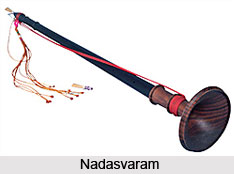 Nadasvaram is a double reed instrument used in South Indian Music. It has traditionally been associated with performance in Hindu temples. Only recently has it been played in more secular concert situations. It is most appropriately played outdoors, because its sound, and the sound of the tavil (drum) that traditionally accompanies it, carries very well. Nadasvaram and tavil frequently figure in temple processions. For a long time, the Nadasvaram players adhered very strictly to tradition such as the allotment of different parts of the day to different ragas. They also preferred to play sustained and elaborate improvisations rather than complete songs.
Nadasvaram is a double reed instrument used in South Indian Music. It has traditionally been associated with performance in Hindu temples. Only recently has it been played in more secular concert situations. It is most appropriately played outdoors, because its sound, and the sound of the tavil (drum) that traditionally accompanies it, carries very well. Nadasvaram and tavil frequently figure in temple processions. For a long time, the Nadasvaram players adhered very strictly to tradition such as the allotment of different parts of the day to different ragas. They also preferred to play sustained and elaborate improvisations rather than complete songs.
Structure of Nadasvaram
The Nadasvaram is usually two to two and a half feet long. Usually-made of wood, it has a conical bore flaring out toward the lower end, and a separate, detachable bell. Ordinarily, it has twelve holes - eight in front and two on each side. Only the upper seven, however, are used for playing. The remaining ones can be filled with wax in order to adjust the pitch register at the player`s discretion. The double reed is fixed on a metal staple at the top end of the instrument and therefore does not extend down into the instrument. Spare reeds and an ivory needle with which the reeds are cleaned and adjusted are attached to the mouthpiece and trail down decoratively, when the Nadasvaram is played. While playing the instrument, the performers make maximum use of the technique whereby the finger holes are covered only partially while playing. In addition, they vary their tongue and lip contact with the reed.
Players of Nadasvaram
Some of the most outstanding players of the Nadasvaram are Sheikh Chinna Maulana, T. N. Rajarathnam Pillai, and K. Pichiappa. The drone instrument used with the Nadasvaram is frequently the ottu, another double-reed instrument. The ottu is larger than the Nadasvaram but has only five or six holes, which are placed toward its lower end. Performers close the holes wholly or partially in order to obtain the desired drone pitch. The technique of circular breathing, which uses the cheek cavity as an air chamber, keeps the source of air (and therefore the drone) constant.




















